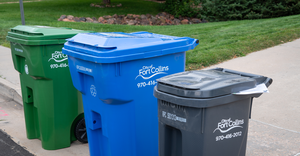What Does Waste Management Look Like in Tribal Communities?

Tribal communities face unique circumstances around waste management that challenge their capacity to operate effective programs. Many of these circumstances center around three issues: those tied to the law, to infrastructure, and to environmental exposure risk. This article touches on these three areas; highlights the U.S. Environmental Protection Agency’s (EPA) Tribal Waste Management program to address solid and hazardous wastes; and tells some of the waste management story of Saint Regis Mohawk Tribe in Akwesasne, NY—one of about 574 federally recognized tribes in the U.S.
On the legal front, tribes’ authority to enforce laws is often limited, says Lynn Zender, executive director of Zender Environmental Health and Research Group in Anchorage, Alaska, a nonprofit working with tribal communities to bolster their solid waste management capacity.
She explains: The EPA delegates authority to states to enforce their solid waste management program under the Resource Conservation and Recovery Act (RCRA); but this authority is not delegated to tribes, who do not administer RCRA programs on behalf of EPA. Rather they run their own, independent governments and are for the most part on their own to compel compliance with their waste management rules. Zender has seen this task prove an uphill battle, particularly when there are nontribal members within the community.
“It’s common for reservations to have land within their boundaries owned by nontribal members [called fee lands] that is generally not under the direct jurisdiction of the tribe. Without practical jurisdiction over nontribal members, it’s difficult for instance to enforce consequences for illegal dumping or to recover fees if they use the tribal transfer station.
It’s a problem because to run a solid waste program you need control over the full land area and how people practice solid waste management in that area,” Zender says.
Tribes sometimes work with counties to tackle jurisdictional issues of this nature, including through a process called cross deputization whereby state law enforcement and tribes can cross jurisdictions in criminal cases. Additionally, the U.S. EPA provides some guidance on creating codes and ordinances and on enforcing them.
Lacking infrastructure is another common conundrum in Indian country, given that these communities are typically low-income and situated in very rural spaces.
They may not have paved roads, and they have to service a very spread-out population, so there’s greater-than-average wear and tear on waste trucks but limited capital to repair them—or to manage other maintenance and operational expenses.
Resources are often limited or compromised. Landfills, and sometimes transfer stations that commonly bridge tribal communities to landfills, may be remotely located. And many non-municipal solid waste disposal sites, particularly harmful waste-containing C&D facilities, are unlined.
The infrastructure problems contribute to exposure issues and potential resulting impact on public health.
Leachate contamination is a big problem due to the unlined disposal sites and lack of federal regulations around them. Illegal dumping, a result in large part to limited disposal resources, further compromises environmental conditions and the communities’ health.
“These exposure risks are prevalent as many people on reservations eat fish from rivers, and there is concern about leachate from unlined sites or illegal dumping infiltrating water. This is a primary consideration because the land – and the ability to live off that land—–is central to the identity of tribes,” Zender says.
The National Tribal Toxics Council is collaborating with the U.S. EPA to better profile types of exposures that tribes might have because of their unique life ways and because they are more likely to have substandard disposal sites. They are working to identify not only types of exposures but types of disposal facilities so EPA can better incorporate exposure in their risk assessment models.
Saint Regis Mohawk Tribe has come a long way since around 2000 when open dumps and burn barrels were a way of life.
Like most tribes in the U.S., the rural, Upper New York reservation on the Canadian border now has its own transfer station, funded by EPA grants and other government monies. Residents and haulers drop off trash and recycling there, including electronics, tires, scrap metal, and white goods. Trash is moved on to a county landfill; and recyclables go to a larger transfer station, as the nearest materials recovery facility (MRF) is over 40 miles away.
The community also has a centrally located depot to drop off recyclables; a program where residents can buy blue bags for their trash and have it picked up; and trash and recycling collection services for nonresidential tribal buildings.
Saint Regis Mohawk’s solid waste program has gotten creative in its financing since, as a tribe, money funnels in and out of the community differently than is traditional in the U.S.
“As a sovereign nation, homeowners and businesses do not pay taxes, so our program needs to generate its own revenues. We are supplemented by businesses and individual tribe members,” says Lisa Furnace, Solid Waste program manager, Saint Regis Mohawk Tribe.
Homeowners pay into the system through the blue bag program for trash. And or they pay a fee to use the transfer station as do private haulers and other businesses.
In addition to these fees for services, some of casinos’, cigarette businesses’, gas stations’, and other companies’ revenue comes back to the solid waste program.
The U.S. EPA’s Tribal Waste Management Program provides financial assistance and technical support to sovereign nations. Among specific offerings are grants, education and outreach trainings, and help facilitating waste program peer matches, with the latter being opportunities for tribes and Alaska Native villages to exchange experiences and knowledge through a mentoring program.
“EPA’s tribal waste management program was initiated to help build tribal capacity for the development and implementation of sustainable waste management programs. The program helps address the challenge of being easily accessible and available to remote locations of tribal communities, as well as improving collaboration and partnerships,” an EPA spokesperson wrote to Waste360.
The agency’s grant program is available to tribal governments and intertribal consortia for developing and implementing hazardous waste programs and building capacity to improve and maintain regulatory compliance. Approximately 120 grants have been awarded, totaling $8.5 million, since its inception.
EPA also works with other federal agencies to help support tribes, with an example being a collaboration whereby the Department of Health and Human Services and EPA provide for the Indian Health Service to consult with EPA to address closure of open dumps or inadequate solid waste facilities on tribal lands.
EPA also collaborates with its Tribal Infrastructure Task Force federal agency partners (i.e., Department of Agriculture, Department of Health and Human Services, Department of Housing and Urban Development, Department of the Interior, and Federal Emergency Management Agency) on initiatives with similar focuses.
While there are often common threads in their waste management issues, each tribe is unique, so some of their needs and approaches are diverse. As varied is where communities are along their path.
Among current work of Saint Regis Mohawk Tribe is to expand its focus on recyclables.
“For now, we pay to have someone take most of our recyclables since we have not been able to fund our own MRF. But commodities are going up in value, so we are looking to establish agreements with MRFs where they will pay us,” Furnace says.
The tribe began baling cardboard in April, which it sells and delivers to a nearby paper company. Now it’s looking for off takers of baled plastic.
As markets have improved, the tribe, who grew from having no means even to ship out recyclables, to recovering and moving them, sees staying closer to the recyclable stream as a smart move. It’s a way to become stronger economically while having a more direct role in its sustainability story.
About the Author
You May Also Like




